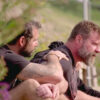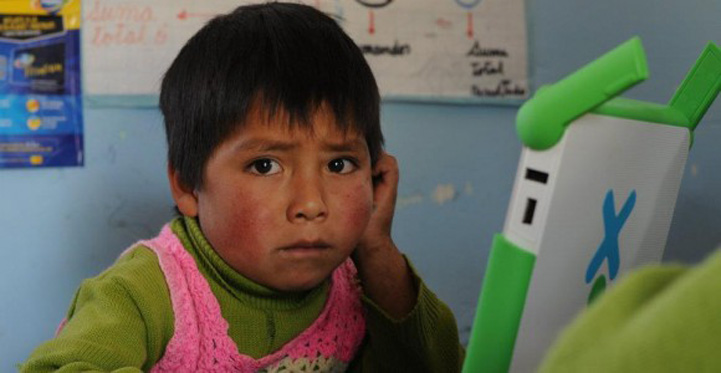DOC NYC, which has quickly established itself as one of America’s preeminent nonfiction film festivals, begins tonight in New York, hosting many of our favorite documentaries of the past year including “Blackfish,” “Levitated Mass,” “The Act of Killing,” “Dirty Wars,” “We Always Lie to Strangers,” “Stories We Tell,” “The Dark Matter of Love” and “The Square.” Surely there will be others that we could add to this list after this weekend, but one we can say for certain now is Michael Kleiman’s “Web,” a project that’s been in the works for the past four years and will make its world premiere on November 16th.
For a film about global connectivity, it’s only fitting that Kleiman himself was drawn to the subject after tying a few strands in his own life together, having read Robert Wright’s “Nonzero,” a historical overview of technology’s role in making the world a smaller place, and soon after attending his sister’s graduation at Cornell where former President Bill Clinton urged the audience to read the book in his commencement address. Since Kleiman had already done that, he took the next step – or about a million of them – to the two small ranching villages of Antuyo and Palestina, Peru to see for himself the impact technology could have on a community as the One Laptop Per Child initiative introduced the Internet into the region. From the summer of 2009 through the summer of 2010, Kleiman embedded himself in the country, collecting over 200 hours of footage that he would then incorporate with interviews with the likes of Wikipedia’s Jimmy Wales and author Clay Shirky to show how the Internet is changing society and how a society that is just getting the Internet now can shape their digital future.
Shortly before Kleiman unveils the film at DOC NYC, he took the time to talk about how he first learned about the mission of One Laptop Per Child, traveling to Peru via an Air Force Cargo flight, what it’s like showing a film in a place less familiar with it and how he hopes the film will raise awareness for the need for the Internet in such remote areas.
How did this idea of connectivity become something so strong you wanted to pursue a film about it?
It was in the back of my head for a couple of years, then I was doing research for something else and stumbled across One Laptop per Child. The light bulb went off, and I thought, “Here’s a program that’s bringing digital technology and the Internet to kids in the most remote parts of the world that’s literally showing this web growing wider and wider and bringing more people together. What’s going to happen to all of us as the Internet extends to the furthest corners of the planet?” I saw that as a really emotional story I could tell. I reached out to Nicholas Negroponte, and they were very amenable and connected me to the right people in Peru to make it happen logistically.
Was that how you found this village in Palestina?
One Laptop per Child in each host country is run by the national government, so I went to Peru where it’s run by the Ministry of Education. I met with them early on and just started speaking logistically. One school was getting the laptops for the first time, and they let me see that. I also wanted to go to a school that was getting Internet access, so they told me about the village that was in the most remote part of the country, but in order to get to it, I had to take these Air Force cargo flights that left from Lima every 15 days. Then you have to take a 10-hour boat ride down river, and they didn’t have electricity, and they didn’t have running water, but they had a solar-powered Internet satellite. As soon as they told me that, I said, “I’ve got to go there.”
One of the most interesting ideas in the film for me was how more than a few of the people you spoke to talked about their fears of the Internet taking over too much of people’s lives, and here you are in Peru they’ve got an opportunity to start fresh and create their own relationship with the online world. Was this an idea you considered before or did it evolve as production wore on?
It was a little bit of both. Going into it, I knew I wanted the film to reflect on the digital divide and how certain people don’t have access to the Internet, but the other part of it was this point you’re getting at, which is I really wanted to able to be a reflection point for the people here to think about how overexposed we are on the Internet and seeing the future of people that are getting connected for the first time and making them wrestle with, “Is that a good future? Is that a future we want for them?”
I had that idea going in, but what I think really came out while I was down there, which for me, is the most potent part of the film is this relationship piece. I became very, very close with the people that I lived with and spent a lot of time connecting with them – sharing in household chores and their meals – and analyzing the power of that connection between two people from two sides of the world leading very different lives. To me, it parallels the digital connection that we have online, and yet this is a much more potent form of it. It’s more meaningful than just someone you meet online somewhere, so that theme really grew as my relationships formed with the people down there.
Have you been keeping in touch with the people in Peru at all to see what’s transpired there?
Yes, absolutely. In August, I was able to go back down to Peru with some support from the U.S. Embassy, and I went back to both reconnect with the people down there and also show them the film, which was a really rewarding experience for me. I also think it was for them and that was the closing chapter to the whole production.It’s obviously tough to do things like that. It’s tough to get to Peru, number one, but then to the most isolated parts of the country as well, to find the time and the money to do it, but I promised them before I left I’d show them the film and was glad that I was able to.
Was it interesting to show a film in a place like that? They must have a relationship with film since one of the most amusing scenes in the film is when the boys take advantage of their newfound Internet access to search for Jean Claude Van Damme.
Yes, especially to show a film that they’re in. They get a real kick out of seeing themselves on screen. This is actually an aside, but the first week when I was in the village of Antuyo, one of the family’s oldest daughters was getting married, so they invited me to the wedding as long as I would film it for them, which, of course, I agreed to. I had like five or six hours of footage of the wedding, and I took a day and edited it down to a nice 45-minute video for them, and I showed it to them. They were like, “What happened to the rest of it? We want to watch all of it,” so I finally gave them all the raw footage, and they would just sit and watch themselves dancing and celebrating. They just loved it.
I was expecting them to really [enjoy] watching themselves on the screen, and they did get a real kick out of that, but I think what was more powerful for them was knowing that people here will be seeing it as well and that people here would get a little bit of insight into their lives down there — what we know of them and what their lives are — so they’re really excited about that prospect.
You mentioned working with the U.S. Embassy earlier and there was also One Laptop Per Child to consider. Was it an interesting experience coordinating those kind of entities during the production of this?
We very intentionally kept One Laptop Per Child at arm’s length after the production process because we wanted to keep our independence, so we made sure that they were never involved in the funding, and they had no sort of creative control. Actually, I don’t think anyone from One Laptop Per Child has seen the film yet, but they were obviously very important to helping us coordinate and also Nicholas Negroponte and Walter Bender participated the interviews, so they were really helpful. They were supportive and made a lot of very important introductions for us, but they definitely did not get involved in the day to day, and I don’t think they had any interest in it, either.
The U.S. Embassy was interesting. The original financing for the film came through a Fulbright Grant from the State Department that paid for me to go down to Peru and through that, I was able to meet some people at the Embassy, and they were really interested [in the film]. They have a whole program that’s dedicated to cultural exchange and bringing American culture to Peru, and Peruvian culture to America and the film fit right into that mission, so they supported the film with a small grant when I was down there. As soon as I finished, they were excited about bringing me down to show it.
Your production company is called Righteous Pictures, with a mandate for social action, so are there ways you’re getting people involved beyond the film?
There’s a couple of things. Our first film “The Last Survivor” was ultimately about genocide prevention, which, from a social action standpoint, is a lot easier than “Web,” because the idea is genocide is a terrible, horrible thing, and how can we use the film to mobilize people against it? With “Web,” it’s a little bit more nuanced. We want people to see it as a reflection point to think about their own lives and how they might be a little bit overexposed to the Internet and the ways that they can find that balance a little bit more. But we don’t want to be throwing it in your face like, “Here’s the Internet. Great.”
There are just about five billion people around the world who don’t have access to the Internet. That’s something that most people aren’t aware of, and one of the things that I hope the film shows is that even though oftentimes we throw it against the list of really important priorities like basic needs or infrastructure such as having a road versus the Internet, a lot of times, the idea of connectivity for most people here falls to the bottom of the list. People think it’s really not that important, but this film articulates how much people in isolated areas want that kind of connectivity. They know that this technology exists and they’re aware that the rest of the world is connected to each other in this way. They want to be a part of that and helping prioritize that a little bit in the minds of the general population and policy makers as well. So we’re teaming up with an organization called A Human Right, and actually, Kosta Grammatis, who started A Human Right is featured in the film, and their whole mission is to bring Internet access to people around the world who don’t have it and raise awareness of the need for Internet access around the world, so we’re hoping that the film will serve as a platform for the issue, and people can learn more about it and go to ahumanright.org and get involved in the issue on a more meaningful way.
“Web” will play twice at DOC NYC on November 16th and November 19th at the IFC Center in New York. It does not yet have distribution.




